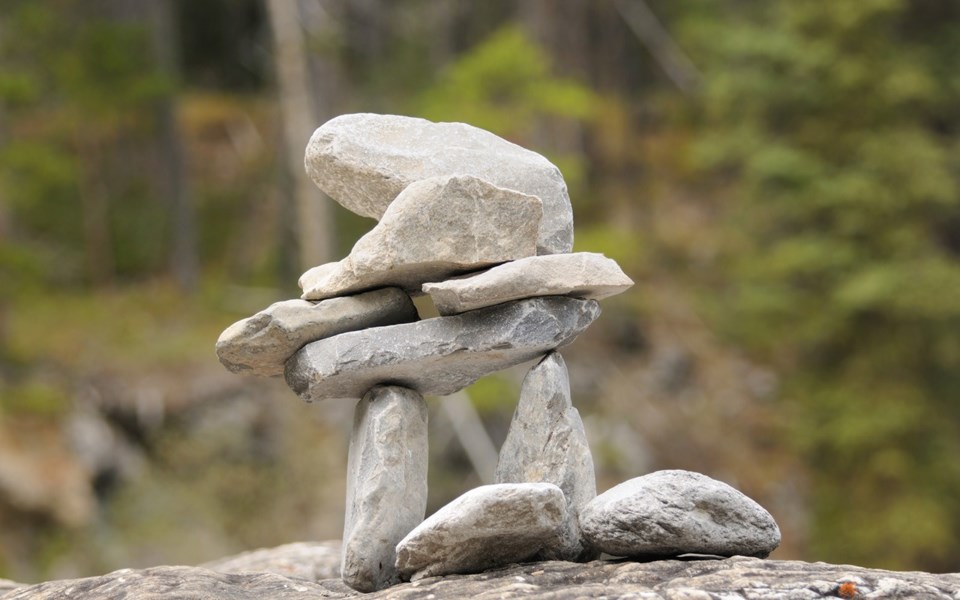Whistler's manifold problem with people disrespecting its nature and environment is something many of us have talked about of late.
One widespread conclusion has been that we—citizens, businesses and government alike—must instil respect for our environment at a grassroots level, inculcating this into our own actions and planning such that visitors are instantly imbued with the same sense of the reverence we hold for our surroundings.
But here's the thing about the bottom-up approach: we can pick up garbage and dog poop, uproot invasive species, report illegal camping, and warn folks who throw cigarette butts of the fire danger, but if we leave or encourage other visual signposts of disrespect, entitlement and unconscious behaviour, we'll get nowhere.
One of the worst examples of this is a trend that has recently reached a fever-pitch of silliness—enough to make the news almost every summer since 2013: the stacking/balancing of rocks in wilderness and/or natural areas.
I've increasingly noted this behaviour everywhere from backcountry areas to the Duffey Lake Road, to the Sea-to-Sky Trail to, most recently, the top of Whistler Mountain, where people are literally falling over themselves trying to "outstack" each other in a dubious competition that is: a) dangerous, as it involves precipices; b) aesthetically disturbing and distracting, and; c) highly impactful on the delicate alpine ecosystem.
Now, you could say the jury is out as to whether the environs on Whistler's peak and the lookouts around the new Cloudraker Skywalk can be considered any form of natural area. But what you see in terms of infrastructure, trails and humans is merely superficial. As with much of nature, the ground beneath your feet is a world unto itself; a microcosm of wilderness, home and habitat to countless creatures from lichens to bacteria, colonizing plants, insects (including pollinating butterflies and bees), spiders, pikas, marmots and birds—all of which, on an alpine mountaintop, are linked in some way to a fragile web centered on rocks.
Never mind the needs of those organisms that are truly saxicolous (the biological word for rock-dwelling and/or dependent), for it serves no one and no thing in either the tourism or natural equations to have people swarming over these habitats piling up every rock within sight. Not only does this present a liability and violate the mountaintop experience for others is, as I suggested earlier, a semaphore of our total and utter disregard for the environment at a time when we should be desperately flagging out messages to the opposite.
Soil development in the alpine is a slow process, requiring thousands of years. The breakdown products of physical and chemical weathering, along with microbial and lichen activity, create nascent soil between, under and around rocks. Moving even the smallest rocks increases erosion by exposing the soil underneath, allowing it to wash away and leave nothing for the native plants (like alpine heather) that call these harsh environments home. And every rock disturbed is the loss of a potential or real home for small animals.
Even the large worldwide community of "stone balance artists" eschew this behaviour. As one wrote in response to an online debate on the issue: "I am very concerned about the practice of leaving stacks of stones littering natural areas... We build our balances, take some photos, and then dismantle. We strive especially to avoid disturbing natural and protected areas."
Unfortunately, stacking then unstacking stones already violates the Leave No Trace ethos, as noted in another post: "Leave No Trace principles aren't just about trash. Leave No Trace means leave no sign that you travelled through the area. That's zero impact. When you move rocks to create decorative cairns you are altering nature for the next visitor and leaving a reminder that you were there."
What should rock cairns be for? Navigation and safety, as per tradition, marking trails with minimal disruption to the natural environment, avoiding the need in wild areas for unnatural and expensive signage.
In any other context, stacking rocks is just another arrogant "I was here" statement fully equivalent to tagging a summit with spray paint—something we'd never condone. But given that the rock-stacking meme has spread globally and deeply into frontcountry/tourist culture (thank you, social media), what to do?
There's only one solution: shut it down wherever and whenever you can; educate, fully discourage and, in cases of true peril or impact, forbid it. And unstack those rocks.
Leslie Anthony is a biologist, writer and author of several popular books on environmental science.




